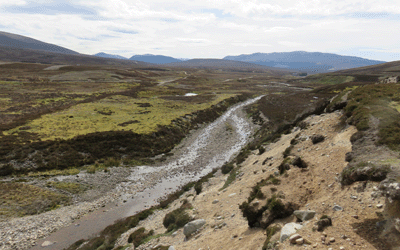We are facing a crisis from the changing climate with nine of the ten warmest years occurring since 2002, and seven of the ten wettest since 1998. Climate change could see summers in Scotland up to 4.8 degrees warmer and 40% drier, with droughts becoming more frequent. At the same time, we are also likely to experience more frequent and damaging floods.
Climate change is likely to increase uncertainty and may cause issues in areas that have not previously experienced water scarcity. These water scarcity events can be exacerbated by land use (such as agricultural draining schemes and associated maintenance) and abstraction.
Abstraction
Water abstraction is the removal or diversion of water from the natural water environment, by a variety of means, including pumps, pipes, boreholes and wells.  Abstractions are regulated by SEPA through the Controlled Activity Regulations (CAR). An abstraction requires authorisation, whether it is carried out on a permanent or temporary basis.
Abstractions are regulated by SEPA through the Controlled Activity Regulations (CAR). An abstraction requires authorisation, whether it is carried out on a permanent or temporary basis.
SEPA have identified the following risks arising from abstraction: drying out of rivers and wetlands; high variable flows of water below hydropower stations and water supply reservoirs, resulting in bare banks and potential stranding of fish; changing water levels in reservoirs, leading to regular drying out of the shoreline and preventing growth of plants and access to spawning fish; death of fish from passing through turbines; interference to the flow of sediment downstream of dams, which reduces the amount of gravel available (needed by fish to spawn); and interference with other users of the water environment (e.g. loss of dilution capacity and resulting deterioration of water quality, or loss of abstraction capacity).
Flow Regulation
As highlighted above, variable flows of water below hydropower stations and water supply reservoirs can result in bare banks and potential stranding of fish. Changing water levels above dams can lead to regular drying out of the shoreline and preventing growth of plants and access to spawning fish.
Water Scarcity
During the hot, dry summer in 2018, there was signifcant concern about water scarcity in Scotland. As a result, SEPA issued weekly situation reports, and this approach has continued each summer since then. The reports and current status can be viewed on the SEPA website. Fisheries Management Scotland have joined SEPA’s water scarcity communications group, which is working to ensure water users understand their responsibility to use water efficiently. In 2021, SEPA consulted on proposals to improve the current situation, including changes to existing abstraction licenses. We continue to press SEPA for additional action to address these issues.
Flooding
Understanding how floods affect salmon is complicated as floods will affect different life stages (e.g. eggs and adults) differently, and the timing and duration of floods will affect these life stages differently.
Salmon lay their eggs in gravels, and this helps to protect them from adverse environmental conditions, such as high flows. High velocity water can wash eggs out of spawning gravels causing them to die. If eggs survive the floods, salmon then emerge as fry. Fry tend to stay in the shallow and protected waters at the edges of river channels to avoid predators and shelter from high flows. High flows during, or shortly after emergence have been associated with high fry mortality – they too can be washed out of the river and die. However, fry swimming ability increases quickly with size and so the timing of the flood is critical to fry survival.
What are we doing?
Fisheries Management Scotland, and our members, are working to ensure that issues relating to water quantity are effectively managed to ensure that sufficient water is available for all life stages of migratory fish. We engage with SEPA on these issues through the Fish and Fisheries Advisory Group, and we recently responded to SEPA’s water resources consultation and the consultation on the third River Basin Management Plan.
